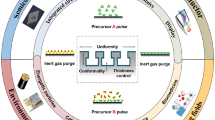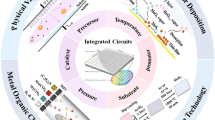Abstract
Gate oxynitride structures of TFT-LCDs were investigated by SIMS, and successful solutions are demonstrated to overcome difficulties arising due to the charging effects of the multilayer systems, the matrix effect of the method, and the small pattern sizes of the samples. Because of the excellent reproducibility achieved by applying exponential relative sensitivity functions for quantitative analysis, minor differences in the barrier gate-oxynitride composition deposited on molybdenum capped aluminium-neodymium metallisation electrodes were determined between the centre and the edge of the TFT-LCD substrates. No differences were found for molybdenum-tungsten metallisations. Furthermore, at the edge of the glass substrates, aluminium, neodymium, and molybdenum SIMS depth profiles show an exponential trend. With TEM micrographs an inhomogeneous thickness of the molybdenum capping is revealed as the source of this effect, which influences the electrical behaviour of the device.
The production process was improved after these results and the aging behaviour of TFT-LCDs was investigated in order to explain the change in control voltage occurring during the lifetime of the displays. SIMS and TEM show an enrichment of neodymium at the interface to the molybdenum layer, confirming good diffusion protection of the molybdenum barrier during accelerated aging. The reason for the shift of the control voltage was finally located by semi-quantitative depth profiling of the sodium diffusion originating from the glass substrate. Molybdenum-tungsten was a much better buffer for the highly-mobile charge carriers than aluminium-neodymium. Best results were achieved with PVD silicon oxynitride as diffusion barrier and gate insulator deposited on aluminium-neodymium metallisation layers.





Similar content being viewed by others
References
Dreer S, Wilhartitz P (2003) Pure Appl Chem (accepted for publication)
Dreer S (1999) Fresen J Anal Chem 365:29–38
Dreer S, Wilhartitz P, Piplits K, Hutter H, Kopnarski M, Friedbacher G (2000) Mikrochim Acta 133:75–87
Homma Y (1994) In: Benninghoven A, Nihei Y, Shimizu R, Werner HW (eds) Secondary ion mass spectrometry SIMS IX. Wiley, Chichester, UK, pp 135–139
Breuer U, Holzbrecher H, Gastel M, Becker JS, Dietze H-J (1995) Fresen J Anal Chem 353:372
Gnaser H, Oechsner H (1991) Fresen J Anal Chem 341:54
Okada Y, Tobin PJ, Hegde RI, Liao J, Rushbrook P (1992) Appl Phys Lett 61:3163
Acknowledgements
The authors wish to thank F. Hofer, W. Grogger, and P. Warbichler from the Center for Electron Microscopy for performing the TEM analysis, and for valuable discussions.
Author information
Authors and Affiliations
Corresponding author
Rights and permissions
About this article
Cite this article
Dreer, S., Wilhartitz, P., Piplits, K. et al. Quantitative SIMS depth profiling of diffusion barrier gate-oxynitride structures in TFT-LCDs. Anal Bioanal Chem 379, 599–604 (2004). https://doi.org/10.1007/s00216-003-2468-y
Received:
Revised:
Accepted:
Published:
Issue Date:
DOI: https://doi.org/10.1007/s00216-003-2468-y




